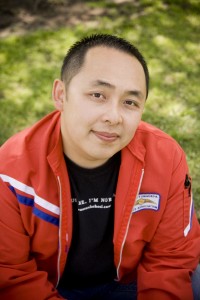
Andre Yang is a Hmong American poet from Fresno, California. He is a founding member of the Hmong American Writers’ Circle (HAWC), where he actively conducts and participates in public writing workshops. He completed the Creative Writing (Poetry) MFA program at California State University, Fresno, where he was a Philip Levine Scholar, recipient of the Academy of American Poets-sponsored Ernesto Trejo Prize, and the Graduate Dean’s Medalist of the College of Arts and Humanities. Andre is a Kundiman Asian American Poetry Fellow, and has attended the Tin House Summer Writers Workshop, the Napa Valley Writers’ Conference, and recently completed an artist residency at the Ucross Foundation. He co-edited How Do I Begin – A Hmong American Literary Anthology (Heyday, 2011), and his poetry has appeared in Paj Ntaub Voice, Beltway Poetry Quarterly, and the chapbook anthology ‘Here is a Pen’ (Achiote Press).
For APIA Heritage Month 2012, we are revisiting our Process Profile series, in which contemporary Asian American poets discuss their craft, focusing on their process for a single poem from inception to publication. This year, we’ve asked several Lantern Review contributors to discuss their process for composing a poem that we’ve published. In this installment, Andre Yang discusses his poem “Why I Feel the Way I Do About SB 1070,” which appeared in Issue 3 of Lantern Review.
* * *
In a way, I have been writing this poem all my life, and considering all the things I discuss in the poem, it really does span my life. The poem was written to express my feelings about the inception and implementation Arizona’s Senate Bill 1070, though I also wanted it to capture my thoughts on the interconnectedness of humanity.
I might not have written “Why I Feel The Way I Do About SB 1070” had I not met Francisco Xavier Alarcón at his Ce Uno One book launch in Sacramento, California. I overheard Francisco saying he was attending the Association of Writers and Writing Programs (AWP) Conference later that year in Washington D.C. (2011), and since I too was planning to attend the conference, I used that as a conversation starter and approached him. He mentioned that while in D.C., he would be organizing two off-site Floricanto readings based on his Facebook page, “Poets Responding to SB 1070,” and that well-established poets like Martín Espada would be taking part in the reading. Five minutes into the conversation, he asked, to my complete surprise, if I wanted to participate in the readings. I said I’d be honored, and told him I’d contact him when I felt I had a poem worthy of the purpose.
Months passed and I hadn’t written a thing. When a friend and poet, Anthony Cody, emailed me a CNN article link that discussed the saola, a rare “Asian unicorn,” an intrigue arose from me. I’d never heard of the saola, but I did some research and learned that it lives only in undeveloped, remote regions of Southeast Asia, and avoids areas touched by humans, to the extent that no biologist has ever seen it in the wild. The article mentioned that villagers in Laos once caught a saola and held it in captivity while awaiting the arrival of scientists, but that the animal died shortly after the scientists arrived. There has never been a successful case of anyone keeping a saola alive in captivity.
Learning about this saola and its death reminded me of another article I’d read a few weeks earlier about an elderly (and sickly) Hmong man from Visalia, California, who filed a lawsuit under the pseudonym John Doe Xiong. Because of his deteriorating health, Mr. Xiong wanted to return to Laos, where his wife and children still lived, to die amongst his loved ones and be buried in the land of his birth. Because his Laotian passport was taken from him by the U.S. Immigration and Customs Enforcement agency when he took refuge in the United States, however, he was unable to make that journey back. I couldn’t help but relate his struggle with the captive saola, how their fates were determined by another’s decisions. As a member of the first generation of Hmong people to be born in the United States, I’m always aware of my Hmongness. How my people lived in the highest regions of the mountains of Laos in order to not be subject to the rules and laws of other lowland (and foothill) peoples. How we’ve no place left on this planet to run to to avoid living amongst others. How, considering all we’ve been through (the diaspora, the immersion into modern societies), so many of our elders are still so resistant to change.
Reading about the saola also triggered a memory of my meeting Sherman Alexie at AWP in Denver. In a private conversation with Alexie, I mentioned that I was a Hmong American poet, to which he responded, “I know the Hmong. The Hmong are the Native Americans of Asia.” I somehow made it through the rest of the conversation without stumbling. Afterwards I immediately called my wife (fiancé at the time) and, in a mix of tears and garbled words, expressed my surprise that Sherman Alexie, someone I didn’t expect to even know the Hmong existed, not only knew of us, but identified with us so closely. To Alexie, our two peoples were metaphors for one another. I considered this with the fact that many Chicanos/Latinos also have indigenous blood, and soon all these things converged, combined, and spilled onto the page as a poem. I went on to workshop the poem at the Hmong American Writers’ Circle and in the Fresno State MFA Program, which helped me refine and reorder the material, but for the most part, it was my existence that guided the process.
2 thoughts on “Process Profile: Andre Yang Discusses “Why I Feel the Way I Do About SB 1070””